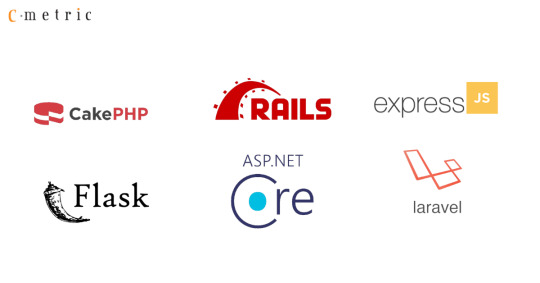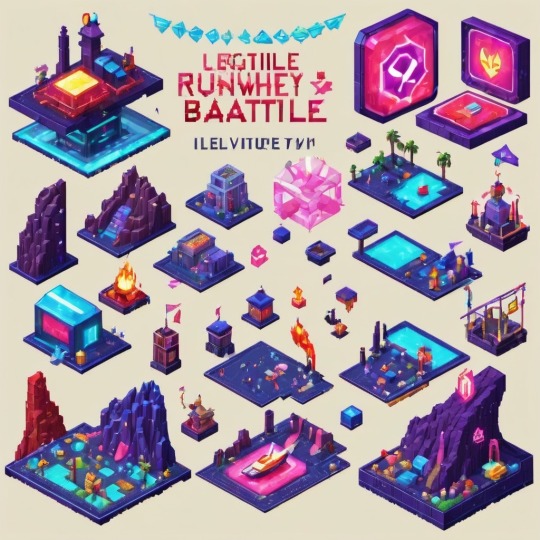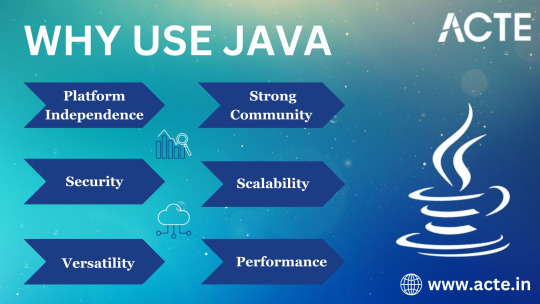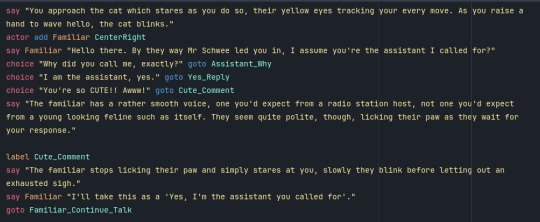#top backend frameworks
Explore tagged Tumblr posts
Text
Top Backend Frameworks Shaping Future of Web Development

The future of web development is being significantly shaped by top backend frameworks, which are defining the way modern web applications are conceived, developed, and deployed. These frameworks serve as the cornerstone for building scalable, efficient, and robust web solutions, ensuring that developers can keep pace with the ever-evolving digital landscape.
Frameworks such as ASP.NET Core, Laravel, and Express.js are at the vanguard, each contributing unique features that cater to the diverse needs of the web development community. ASP.NET Core, with its high performance and cross-platform capabilities, is ideal for developers looking to build dynamic web services and applications.
Laravel, renowned for its elegant syntax and expressive codebase, makes complex web development tasks simpler and more intuitive. Express.js, leveraging the power of Node.js, offers a minimalistic yet powerful platform for creating server-side web applications and APIs.
These top backend frameworks are not just tools but enablers of innovation, allowing developers to experiment with new ideas and technologies while maintaining high standards of performance and security.
As they continue to evolve, incorporating advancements in artificial intelligence, machine learning, and cloud computing, they promise to further revolutionize web development, making it more agile, responsive, and aligned with the needs of tomorrow’s digital world. Embracing these frameworks is essential for any web developer aiming to remain at the cutting edge of technology and shape the future of the internet.
0 notes
Text
Node.js Development: Everything You Need to Know in 2025
In 2025, Node.js development continues to be a powerful tool for building efficient, scalable, and real-time applications. This backend JavaScript framework has become a go-to technology for backend development, favoured by developers for its speed, flexibility, and vast ecosystem. Here’s everything you need to know about Node.js development trends, advantages, and key considerations in 2025.
Why Node.js Remains Popular in 2025
Node.js has gained a strong foothold in web and app development due to its high performance and ability to handle large volumes of simultaneous requests, making it ideal for data-intensive applications. Its non-blocking, event-driven architecture allows developers to build scalable web applications that can easily support thousands of concurrent users.
Key Node.js Trends to Watch in 2025
Serverless Architecture: Serverless is growing in popularity, and Node.js serverless applications fit perfectly with this trend. In a serverless environment, developers don’t need to manage server infrastructure; they focus instead on writing code. This approach can reduce development costs and improve scalability, making Node.js a key player in the serverless computing market.
Edge Computing: As demand for faster data processing rises, Node.js for edge computing is becoming crucial. By enabling data processing closer to the data source, Node.js helps reduce latency and improve application performance, particularly in real-time applications.
Microservices Architecture: Microservices are essential for large-scale, modular applications. Node.js, with its lightweight nature, is perfect for Node.js microservices architecture, allowing developers to build small, independent services that can be deployed and scaled individually.
Artificial Intelligence (AI) and Machine Learning (ML) Integration: In 2025, integrating AI and ML models into applications is a significant trend. Node.js with AI and ML is compatible with powerful machine-learning libraries, making it an attractive choice for developers looking to create intelligent applications.
Benefits of Using Node.js in 2025
High Performance: Node.js uses the V8 engine, offering impressive speed and efficient execution of JavaScript. This makes it suitable for applications requiring fast response times, such as real-time applications, chat applications, and IoT devices.
Rich Ecosystem: The Node.js ecosystem, including npm (Node Package Manager), gives developers access to a wide range of reusable modules and libraries. This Node.js ecosystem reduces development time and helps accelerate project timelines.
Cross-Platform Compatibility: Node.js Development cross-platform applications work well across different platforms, making it easier for developers to build applications that run seamlessly on various operating systems.
Scalability: The non-blocking, asynchronous architecture of Node.js for scalable applications makes it easy to scale horizontally, supporting increased workloads as businesses grow.
Best Practices for Node.js Development in 2025
Leverage TypeScript: Using TypeScript with Node.js enhances code quality and reduces bugs, making it a valuable addition to any development project.
Prioritize Security: Security is a primary concern for developers, particularly in 2025, as cyber threats grow more sophisticated. Implementing Node.js security best practices, like input validation and rate limiting, is essential for protecting applications.
Adopt CI/CD Pipelines: Continuous integration and continuous deployment (CI/CD) pipelines streamline development and ensure faster, more reliable Node.js deployments.
Conclusion
Node.js continues to be a versatile and high-performance choice for backend development in 2025. Its adaptability to trends like serverless architecture, microservices, and AI integration makes it a prime technology for building future-ready applications. By leveraging the power of Node.js developers, businesses can develop scalable, efficient, and intelligent solutions to stay ahead in the digital landscape.
#Node.js development trends 2025#Node.js development best practices#Node.js for web development 2025#latest features in Node.js 2025#Node.js performance optimization#Node.js vs other frameworks 2025#Node.js for backend development#Node.js security best practices#scalable Node.js applications#future of Node.js development#full-stack development with Node.js#Node.js development services USA and UK#how to hire Node.js developers#Node.js in microservices architecture#Node.js for real-time applications#top Node.js frameworks 2025#Node.js development tools#asynchronous programming in Node.js#Node.js for enterprise solutions#Node.js and serverless architecture
1 note
·
View note
Text

Explore the top backend frameworks for 2024 with confidence by partnering with XcelTec, a premier custom web development company in the USA. Our experienced team specializes in working with various frameworks, ensuring your project receives experts.
0 notes
Text
Backend frameworks are the technologies used alongside backend programming languages that create the logic and functionality behind a software application.
Backend frameworks for web development have gained so much popularity as we navigate through an era of digital dependence.
In this article we have listed the top 10 backend framework you can opt in 2023
Explore more: https://generaleducator.com/developers-choice-an-overview-of-the-best-back-end-frameworks-in-2023/
0 notes
Text
Programming object lesson of the day:
A couple days ago, one of the side project apps I run (rpthreadtracker.com) went down for no immediately obvious reason. The issue seems to have ended up being that the backend was running on .NET Core 2.2, which the host was no longer supporting, and I had to do a semi-emergency upgrade of all the code to .NET Core 6, a pretty major update that required a lot of syntactic changes and other fixes.
This is, of course, an obvious lesson in keeping an eye on when your code is using a library out of date enough not to be well supported anymore. (I have some thoughts on whether .NET Core 2.2 is old enough to have been dumped like this, but nevertheless I knew it was going out of LTS and could have been more prepared.) But that's all another post.
What really struck me was how valuable it turned out to be that I had already written an integration test suite for this application.
Historically, at basically every job I've worked for and also on most of my side projects, automated testing tends to be the thing most likely to fall by the wayside. When you have 376428648 things you want to do with an application and only a limited number of hours in the day, getting those 376428648 things to work feels very much like the top priority. You test them manually to make sure they work, and think, yeah, I'll get some tests written at some point, if I have time, but this is fine for now.
And to be honest, most of the time it usually is fine! But a robust test suite is one of those things that you don't need... until you suddenly REALLY FUCKING NEED IT.
RPTT is my baby, my longest running side project, the one with the most users, and the one I've put the most work into. So in a fit of side project passion and wanting to Do All The Right Things For Once, I actively wrote a massive amount of tests for it a few years ago. The backend has a full unit test suite that is approaching 100% coverage (which is a dumb metric you shouldn't actually stress about, but again, a post for another day). I also used Postman, an excellently full-featured API client, to write a battery of integration tests which would hit all of the API endpoints in a defined order, storing variables and verifying values as it went to take a mock user all the way through their usage life cycle.
And goddamn was that useful to have now, years later, as I had to fix a metric fuckton of subtle breakage points while porting the app to the updated framework. With one click, I could send the test suite through every endpoint in the backend and get quick feedback on everywhere that it wasn't behaving exactly the way it behaved before the update. And when I was ready to deploy the updated version, I could do so with solid confidence that from the front end's perspective, nothing would be different and everything would slot correctly into place.
I don't say this at all to shame anyone for not prioritizing writing tests - I usually don't, especially on my side projects, and this was a fortuitous outlier. But it was a really good reminder of why tests are a valuable tool in the first place and why they do deserve to be prioritized when it's possible to do so.
#bjk talks#coding#codeblr#programming#progblr#web development#I'm trying to finally get back to streaming this weekend so maybe the upcoming coding stream will be about#setting up one of these integration test suites in postman
78 notes
·
View notes
Text
Fullstack .Net Free Workshop
Quality Thought, a leading software training institute with a strong reputation for delivering industry-ready IT education, is excited to offer a Free Workshop on Fullstack .NET Development on 12-July-2025. This workshop is an excellent opportunity for students, fresh graduates, job seekers, and working professionals to dive deep into one of the most in-demand technology stacks – the Microsoft .NET ecosystem.
This hands-on workshop is designed to introduce participants to the complete lifecycle of fullstack development using .NET technologies. From building dynamic backend systems to creating interactive frontend interfaces, attendees will gain exposure to modern web development practices and tools. The workshop also includes a Participation Certificate, adding value to your resume and professional profile.
What You’ll Learn:
ASP.NET Core: Understand how to build high-performance, cross-platform web applications using ASP.NET Core. Learn the basics of MVC architecture, routing, middleware, and authentication techniques to develop robust backend systems.
Entity Framework Core: Discover the power of Entity Framework Core, Microsoft’s modern ORM tool. Learn how to connect applications to databases, perform CRUD operations, and use LINQ queries efficiently through code-first and database-first approaches.
Blazor: Explore Blazor, a revolutionary framework that lets you build interactive web UIs using C#. Whether it's Blazor Server or Blazor WebAssembly, you’ll learn how to create single-page applications (SPAs) without relying heavily on JavaScript.
RESTful APIs: Learn to design and develop RESTful APIs using ASP.NET Core Web API. Gain practical knowledge of creating endpoints, handling HTTP requests, and integrating APIs with frontend applications securely and efficiently.
Frontend Frameworks: Get introduced to popular frontend frameworks and how they work with .NET backends. This includes working with tools like Angular, React, or Blazor to build responsive and dynamic user interfaces.
Why Attend?
Free of Cost: Gain top-quality training without any fees.
Certificate of Participation: Receive a certificate to enhance your LinkedIn profile and resume.
Practical Learning: Hands-on sessions, real-world projects, and code walkthroughs.
Expert Guidance: Learn from experienced trainers with deep industry knowledge.
Career-Oriented Content: Tailored to meet the demands of current software development job roles.
Whether you're new to programming or looking to upgrade your skills, this workshop offers the perfect starting point to explore the world of fullstack .NET development. Don’t miss this chance to learn, code, and grow with Quality Thought. Register today and take the first step toward a successful career in software development!

#workshop#Education#Fullstack .Net#Free Workshop#Certification#Quality Thought#.Net Training#.Net Course
2 notes
·
View notes
Text
Flutter Developers for Hire: Build Better Apps, Faster
In the fast-paced mobile world, speed and scalability matter. That’s why more businesses are turning to Flutter developers for hire to get their apps to market quickly—without sacrificing quality.
Flutter, Google’s open-source framework, enables developers to build natively compiled apps for mobile, web, and desktop—all from a single codebase. But to unlock its full potential, you need the right talent. That’s where Flutternest comes in.
Our team makes it easy to hire Flutter developers who are not only technically sound but also deeply collaborative. From UI/UX design to backend integration and post-launch support, our developers work as an extension of your team.
Whether you’re a startup or an enterprise, having skilled Flutter developers for hire can accelerate your development process and reduce costs. Plus, Flutter’s hot reload feature ensures faster iterations, helping you stay agile and competitive.
Need a partner who gets Flutter and gets your goals? Flutternest connects you with top-tier developers ready to build sleek, scalable, and high-performing applications.
2 notes
·
View notes
Text
Why Python Will Thrive: Future Trends and Applications
Python has already made a significant impact in the tech world, and its trajectory for the future is even more promising. From its simplicity and versatility to its widespread use in cutting-edge technologies, Python is expected to continue thriving in the coming years. Considering the kind support of Python Course in Chennai Whatever your level of experience or reason for switching from another programming language, learning Python gets much more fun.

Let's explore why Python will remain at the forefront of software development and what trends and applications will contribute to its ongoing dominance.
1. Artificial Intelligence and Machine Learning
Python is already the go-to language for AI and machine learning, and its role in these fields is set to expand further. With powerful libraries such as TensorFlow, PyTorch, and Scikit-learn, Python simplifies the development of machine learning models and artificial intelligence applications. As more industries integrate AI for automation, personalization, and predictive analytics, Python will remain a core language for developing intelligent systems.
2. Data Science and Big Data
Data science is one of the most significant areas where Python has excelled. Libraries like Pandas, NumPy, and Matplotlib make data manipulation and visualization simple and efficient. As companies and organizations continue to generate and analyze vast amounts of data, Python’s ability to process, clean, and visualize big data will only become more critical. Additionally, Python’s compatibility with big data platforms like Hadoop and Apache Spark ensures that it will remain a major player in data-driven decision-making.
3. Web Development
Python’s role in web development is growing thanks to frameworks like Django and Flask, which provide robust, scalable, and secure solutions for building web applications. With the increasing demand for interactive websites and APIs, Python is well-positioned to continue serving as a top language for backend development. Its integration with cloud computing platforms will also fuel its growth in building modern web applications that scale efficiently.
4. Automation and Scripting
Automation is another area where Python excels. Developers use Python to automate tasks ranging from system administration to testing and deployment. With the rise of DevOps practices and the growing demand for workflow automation, Python’s role in streamlining repetitive processes will continue to grow. Businesses across industries will rely on Python to boost productivity, reduce errors, and optimize performance. With the aid of Best Online Training & Placement Programs, which offer comprehensive training and job placement support to anyone looking to develop their talents, it’s easier to learn this tool and advance your career.

5. Cybersecurity and Ethical Hacking
With cyber threats becoming increasingly sophisticated, cybersecurity is a critical concern for businesses worldwide. Python is widely used for penetration testing, vulnerability scanning, and threat detection due to its simplicity and effectiveness. Libraries like Scapy and PyCrypto make Python an excellent choice for ethical hacking and security professionals. As the need for robust cybersecurity measures increases, Python’s role in safeguarding digital assets will continue to thrive.
6. Internet of Things (IoT)
Python’s compatibility with microcontrollers and embedded systems makes it a strong contender in the growing field of IoT. Frameworks like MicroPython and CircuitPython enable developers to build IoT applications efficiently, whether for home automation, smart cities, or industrial systems. As the number of connected devices continues to rise, Python will remain a dominant language for creating scalable and reliable IoT solutions.
7. Cloud Computing and Serverless Architectures
The rise of cloud computing and serverless architectures has created new opportunities for Python. Cloud platforms like AWS, Google Cloud, and Microsoft Azure all support Python, allowing developers to build scalable and cost-efficient applications. With its flexibility and integration capabilities, Python is perfectly suited for developing cloud-based applications, serverless functions, and microservices.
8. Gaming and Virtual Reality
Python has long been used in game development, with libraries such as Pygame offering simple tools to create 2D games. However, as gaming and virtual reality (VR) technologies evolve, Python’s role in developing immersive experiences will grow. The language’s ease of use and integration with game engines will make it a popular choice for building gaming platforms, VR applications, and simulations.
9. Expanding Job Market
As Python’s applications continue to grow, so does the demand for Python developers. From startups to tech giants like Google, Facebook, and Amazon, companies across industries are seeking professionals who are proficient in Python. The increasing adoption of Python in various fields, including data science, AI, cybersecurity, and cloud computing, ensures a thriving job market for Python developers in the future.
10. Constant Evolution and Community Support
Python’s open-source nature means that it’s constantly evolving with new libraries, frameworks, and features. Its vibrant community of developers contributes to its growth and ensures that Python stays relevant to emerging trends and technologies. Whether it’s a new tool for AI or a breakthrough in web development, Python’s community is always working to improve the language and make it more efficient for developers.
Conclusion
Python’s future is bright, with its presence continuing to grow in AI, data science, automation, web development, and beyond. As industries become increasingly data-driven, automated, and connected, Python’s simplicity, versatility, and strong community support make it an ideal choice for developers. Whether you are a beginner looking to start your coding journey or a seasoned professional exploring new career opportunities, learning Python offers long-term benefits in a rapidly evolving tech landscape.
#python course#python training#python#technology#tech#python programming#python online training#python online course#python online classes#python certification
2 notes
·
View notes
Text
🏥 What Is a Compliance Management System and Why It’s Crucial for the Healthcare Industry

In an industry where patient trust is everything and data is sacred, regulatory compliance is no longer just a backend task — it’s a lifeline.
Healthcare organizations today face growing pressure to align with evolving rules around data privacy, patient safety, digital recordkeeping, and clinical standards. With lives on the line and liabilities on the rise, staying compliant isn’t just important — it’s non-negotiable.
So, what exactly is a Compliance Management System (CMS)? And why is it becoming mission-critical in modern healthcare?
⚕️ Understanding Healthcare Compliance: More Than Just Paperwork
From HIPAA in the U.S. to the Clinical Establishments Act in India, healthcare providers must adhere to strict regulations at every level. These frameworks are designed to protect patients, ensure ethical medical practices, and safeguard sensitive data.
But the reality? Compliance is complex. Regulations change, audits are stressful, and manual tracking is risky.
That’s where a compliance management solution becomes your best ally.
💻 What Is a Compliance Management System?
A compliance management system is a smart, digital solution that helps healthcare institutions monitor, manage, and maintain their legal and ethical obligations across all operations.
It brings together regulation tracking, automated compliance tasks, document management, audit preparation, and reporting — all in one centralized dashboard.
It’s the brain behind a stress-free, audit-ready healthcare organization.
🏥 Why Healthcare Organizations Need It Now More Than Ever
Whether you're running a hospital, diagnostic lab, clinic chain, or telehealth platform, the right CMS can transform how you operate. Here's how:
🩺 Improved Patient Data Protection Stay on top of global data laws like GDPR, HIPAA, and India’s DPDP Act.
🧾 Automated Compliance Tasks Minimize manual errors and save hours of admin work by automating regulatory tasks.
📑 Always Audit-Ready Instant access to compliance status reports and evidence for inspections or inquiries.
🌍 Multi-Jurisdictional Compliance Serve patients across states or countries? A global CMS handles it seamlessly.
🌐 Thinking Global? You Need the Right Platform
If your healthcare brand is expanding or dealing with multi-country operations, Lawrbit’s Global Compliance Management Solution is built to support your growth.
It simplifies cross-border compliance tracking, maps country-wise obligations, and empowers compliance officers with centralized control — no matter how complex the network.
🇮🇳 In India? Here’s Your Smart Compliance Companion
For healthcare providers operating in India’s diverse regulatory landscape, Lawrbit’s India Compliance Platform is a game-changer.
With real-time law updates, customizable workflows, and dashboards aligned with Indian standards, it makes compliance smooth, transparent, and scalable.
From clinical establishment licensing to biomedical waste compliance — it covers it all.
🧠 Final Takeaway
The healthcare industry holds lives in its hands — and compliance ensures those lives are protected at every step.
Implementing a robust compliance management system is no longer a luxury — it's a strategic necessity for building trust, reducing risk, and delivering quality care.
With platforms like Lawrbit, your organization gets the tools it needs to turn compliance from a challenge into a competitive edge.
#HealthcareCompliance#ComplianceManagementSystem#RegulatoryCompliance#HealthDataPrivacy#MedicalComplianceSoftware#HospitalCompliance#PatientSafety#Lawrbit#GlobalCompliance#IndiaHealthcareCompliance#ClinicalGovernance#ComplianceSolution
1 note
·
View note
Text
Why Indian Developers Are Leading the Global App Development Industry

The global app development industry is experiencing exponential growth, and Indian developers are increasingly becoming the driving force behind this success. From startups to tech giants, Indian talent is powering some of the most innovative, user-friendly, and widely used mobile applications in the world. So, why are Indian developers consistently leading the charge in the app development space? Let’s dive into the key factors that have propelled Indian developers to the forefront of the global app development industry.
1. A Thriving Talent Pool
India is home to one of the largest pools of software developers globally, with over 5 million IT professionals as of recent estimates. The country produces a vast number of graduates each year from top-tier engineering colleges and universities, making it an attractive hub for technology-driven organizations. Many of these graduates specialize in mobile app development, from iOS and Android to cross-platform frameworks like React Native and Flutter.
The size and depth of this talent pool ensure that companies can tap into a diverse range of skills and expertise. Whether it’s backend development, user experience design, or advanced mobile app functionalities, you can hire dedicated developers in India who are well-versed in the latest technologies and industry best practices.
2. Cost-Effectiveness
While Indian developers have a reputation for delivering high-quality work, their services come at a fraction of the cost compared to developers in countries like the United States, the UK, or Australia. This cost-effectiveness makes India an attractive outsourcing destination for companies looking to build world-class apps without breaking the bank.
Outsourcing to India allows companies, especially startups and small businesses, to allocate more of their budget to marketing, business development, and other growth areas. Additionally, Indian developers often work in a flexible and result-oriented environment, ensuring timely delivery without compromising quality.
3. Expertise in Multiple Technologies
Indian developers have earned their reputation for being experts in a broad spectrum of app development technologies. From native Android and iOS development to more recent cross-platform tools like React Native and Flutter, Indian developers excel at mastering multiple technologies. Their ability to seamlessly adapt to evolving technological trends enables them to build highly efficient and user-friendly apps that cater to a global audience.
Furthermore, Indian developers are highly skilled in integrating modern technologies like Artificial Intelligence (AI), Machine Learning (ML), Augmented Reality (AR), and blockchain into mobile applications. This expertise positions Indian developers as leaders in creating innovative, future-ready solutions that meet the demands of today’s fast-evolving digital landscape.
4. Agile Methodology & Adaptability
Indian developers are known for their mastery of the Agile development methodology, which emphasizes iterative progress, flexibility, and close collaboration with clients. Agile allows teams to quickly adapt to changing requirements and feedback, ensuring that the final product aligns closely with client expectations.
This adaptability is especially important in the fast-paced world of app development, where user needs and industry trends can change rapidly. Indian developers are adept at incorporating feedback, tweaking app features, and refining user interfaces to ensure optimal performance and user experience.
5. Focus on Quality & Innovation
While cost-effectiveness is a key factor, Indian developers are not compromising on quality. Indian development teams prioritize best practices, robust coding standards, and rigorous testing processes to ensure that every app they build meets high-quality benchmarks.
Additionally, innovation is at the heart of India's app development ecosystem. Developers continually push the envelope with new features, intuitive user interfaces, and novel app functionalities. Whether it's a highly interactive gaming app or an enterprise-level business solution, Indian developers are continuously finding ways to innovate, differentiate, and enhance their mobile applications.
6. Vibrant Startup Ecosystem
India’s vibrant and rapidly growing startup ecosystem is another contributing factor to the country’s dominance in the app development industry. Indian entrepreneurs are embracing mobile-first strategies, with many startups relying on mobile apps to reach customers and grow their businesses.
These startups often partner with local app development firms or hire in-house developers to bring their app ideas to life. This has led to a culture of innovation and collaboration, where developers are constantly exposed to new ideas, use cases, and challenges. As a result, Indian developers are uniquely positioned to design creative solutions that cater to both local and global audiences.
7. Strong English Proficiency
English is widely spoken and used in the professional domain across India, which makes communication between Indian developers and international clients seamless. Clear communication is essential in understanding project requirements, discussing timelines, and providing updates. Indian developers are accustomed to working with global clients, ensuring that language barriers do not hinder the development process.
Moreover, India’s adoption of English as a primary language of business allows developers to stay updated on global trends, technologies, and frameworks, making them highly competitive in the international job market.
8. Time Zone Advantage
India’s time zone, IST (Indian Standard Time), provides a unique advantage in global app development. Indian developers often work while clients in Western countries are offline, making it possible for companies to take advantage of a "follow-the-sun" model. This leads to faster turnaround times and ensures that work progresses even when other teams are not active.
In essence, this time zone advantage allows for efficient project management, quicker feedback cycles, and 24/7 productivity, which is a key factor in meeting the tight deadlines that are common in the app development industry.
9. Successful Global Track Record
Finally, the successful track record of Indian developers is one of the biggest reasons they are leading the global app development industry. Companies around the world, from Silicon Valley giants to emerging startups, have tapped into the Indian talent pool to build their apps. This success is reflected in the sheer number of high-quality mobile applications developed by Indian teams.
Apps like Flipkart, Ola, Zomato, and Paytm—many of which originated in India—have become household names globally. This success demonstrates the immense potential of Indian developers to create world-class products that can compete in international markets.
Conclusion
Indian developers are undoubtedly at the forefront of the global app development industry, owing to their technical expertise, cost-effectiveness, innovation, and adaptability. With a thriving talent pool, access to cutting-edge technologies, and an unmatched focus on quality, India continues to be the go-to destination for companies seeking to build powerful, user-friendly mobile applications. As the app development landscape continues to evolve, Indian developers are poised to remain at the helm, shaping the future of mobile technology on a global scale.
1 note
·
View note
Text
The Impact of AI on Web Development in 2025
Introduction
Artificial Intelligence (AI) has become a game-changer in various industries, and web development is no exception. From automating coding tasks to enhancing user experience, AI is reshaping how websites are designed, built, and maintained. In 2025, AI will be more fully integrated into web development than ever before, providing developers and businesses alike with smarter solutions.
The Development of AI in Web Design AI’s role in web development has evolved significantly over the years. Initially, AI-powered tools were limited to basic automation, such as code suggestions and spell-checking. However, with advancements in machine learning (ML) and natural language processing (NLP), AI now plays a crucial role in:
Automated website design
Chatbots and virtual assistants
Personalized user experiences
Optimization for search engines (SEO)
Enhanced cybersecurity As AI continues to advance, it is making web development faster, more efficient, and highly adaptive to user needs.
AI-Powered Website Builders AI-driven website builders have revolutionized the way websites are created. Platforms like Wix ADI and Bookmark’s AI-based assistant eliminate the need for extensive coding, allowing businesses to create stunning websites in minutes. These tools analyze user preferences, industry trends, and content to generate customized websites that align with specific business goals.
Benefits of AI-Powered Website Builders
Speed and Efficiency — AI-driven platforms can build a website in minutes, drastically reducing development time.
Customization — AI algorithms analyze industry-specific data to create highly tailored website designs.
User-Friendliness — Even users without technical expertise can develop functional and aesthetically pleasing websites.
AI in Custom Web Development Small businesses can benefit greatly from AI-powered website builders, but businesses need more advanced features. This is where AI-enhanced custom web development services come into play. Developers now use AI-driven frameworks to optimize backend performance, automate repetitive coding tasks, and enhance security.
AI’s Impact on Backend Development
Code Generation and Debugging — AI-powered tools like GitHub Copilot assist developers by suggesting and correcting code snippets in real-time.
Automated Testing — AI-driven testing frameworks identify bugs and vulnerabilities more accurately than manual testing.
Smart Caching and Load Balancing — AI optimizes server performance by predicting and managing traffic loads efficiently.
AI-Driven UX/UI Enhancements User experience (UX) and user interface (UI) design are crucial for engaging visitors and improving conversion rates. AI plays a significant role in refining these aspects by:
Personalization — AI analyzes user behavior to deliver personalized experiences. For example, AI-powered recommendation engines display tailored content, products, or services based on browsing history and preferences.
AI-Powered Chatbots — Modern chatbots leverage NLP to engage with users in a human-like manner. These bots provide instant support, guide users through websites, and even handle transactions.
Automated A/B Testing — AI eliminates guesswork in UX/UI design by running multiple tests simultaneously and determining the best-performing layout, color scheme, or call-to-action (CTA).
AI in SEO and Content Optimization Artificial intelligence (AI) is now a key factor in assisting websites in rising to the top of search engine results. AI-driven SEO tools analyze keywords, predict search trends, and generate content that aligns with search engine algorithms.
Key AI Contributions to SEO
AI-Powered Content Generation — SEO-optimized, high-quality content can be made with the help of tools like GPT-4.
Voice Search Optimization — AI helps businesses optimize their websites for voice-based queries.
Predictive Analytics — AI analyzes user behavior to recommend keywords and content strategies.
AI and Cybersecurity in Web Development With cyber threats on the rise, AI-driven cybersecurity solutions are essential for protecting websites from attacks. AI makes security better by:
Detecting and preventing malicious activities in real-time.
Preventing exploitable vulnerabilities from being discovered and fixed.
Enhancing authentication processes through biometric and AI-driven verification.
The Future of AI in Web Development The future of AI in web development is promising, with advancements expected in:
Fully autonomous coding assistants that build entire applications without human intervention.
Hyper-personalized websites that adapt dynamically to each user.
AI-driven voice and gesture-based interfaces.
Improved AI ethics and regulations to ensure fair usage. As AI technology continues to evolve, it will play an even more integral role in shaping the web development landscape.
Conclusion AI is no longer a futuristic concept — it is actively transforming web development in 2025. From AI-powered design tools to automated coding and enhanced security, businesses and developers are leveraging AI to create smarter, faster, and more efficient websites. Investing in Custom Web Solutions for Businesses is now more critical than ever, ensuring that companies stay ahead in an increasingly digital world. Whether it’s custom web application development or a fully optimized website, AI is paving the way for a more intelligent and user-centric internet. If you’re thinking, “I need a web design”, leveraging AI-driven solutions is the smartest choice for staying ahead in today’s competitive digital landscape.
For businesses looking to integrate AI into their web development strategies, platforms like Paylinkly offer seamless solutions for business credit card processing services, onlinepayment processing services, Credit Card Processing for Small Business, mobile credit card processing, Zero Cost Credit Card Processing, and Chargeback Management Service. Visit Paylinkly to explore AI-powered financial and web solutions today!
#paylinkly#business credit card processing services#online payment processing services#Credit Card Processing for Small Business#mobile credit card processing#Chargeback Management Service#Zero Cost Credit Card Processing
1 note
·
View note
Text
#Playstation7 #framework #BasicArchitecture #RawCode #RawScript #Opensource #DigitalConsole
To build a new gaming console’s digital framework from the ground up, you would need to integrate several programming languages and technologies to manage different aspects of the system. Below is an outline of the code and language choices required for various parts of the framework, focusing on languages like C++, Python, JavaScript, CSS, MySQL, and Perl for different functionalities.
1. System Architecture Design (Low-level)
• Language: C/C++, Assembly
• Purpose: To program the low-level system components such as CPU, GPU, and memory management.
• Example Code (C++) – Low-Level Hardware Interaction:
#include <iostream>
int main() {
// Initialize hardware (simplified example)
std::cout << "Initializing CPU...\n";
// Set up memory management
std::cout << "Allocating memory for GPU...\n";
// Example: Allocating memory for gaming graphics
int* graphicsMemory = new int[1024]; // Allocate 1KB for demo purposes
std::cout << "Memory allocated for GPU graphics rendering.\n";
// Simulate starting the game engine
std::cout << "Starting game engine...\n";
delete[] graphicsMemory; // Clean up
return 0;
}
2. Operating System Development
• Languages: C, C++, Python (for utilities)
• Purpose: Developing the kernel and OS for hardware abstraction and user-space processes.
• Kernel Code Example (C) – Implementing a simple syscall:
#include <stdio.h>
#include <unistd.h>
int main() {
// Example of invoking a custom system call
syscall(0); // System call 0 - usually reserved for read in UNIX-like systems
printf("System call executed\n");
return 0;
}
3. Software Development Kit (SDK)
• Languages: C++, Python (for tooling), Vulkan or DirectX (for graphics APIs)
• Purpose: Provide libraries and tools for developers to create games.
• Example SDK Code (Vulkan API with C++):
#include <vulkan/vulkan.h>
VkInstance instance;
void initVulkan() {
VkApplicationInfo appInfo = {};
appInfo.sType = VK_STRUCTURE_TYPE_APPLICATION_INFO;
appInfo.pApplicationName = "GameApp";
appInfo.applicationVersion = VK_MAKE_VERSION(1, 0, 0);
appInfo.pEngineName = "GameEngine";
appInfo.engineVersion = VK_MAKE_VERSION(1, 0, 0);
appInfo.apiVersion = VK_API_VERSION_1_0;
VkInstanceCreateInfo createInfo = {};
createInfo.sType = VK_STRUCTURE_TYPE_INSTANCE_CREATE_INFO;
createInfo.pApplicationInfo = &appInfo;
vkCreateInstance(&createInfo, nullptr, &instance);
std::cout << "Vulkan SDK Initialized\n";
}
4. User Interface (UI) Development
• Languages: JavaScript, HTML, CSS (for UI), Python (backend)
• Purpose: Front-end interface design for the user experience and dashboard.
• Example UI Code (HTML/CSS/JavaScript):
<!DOCTYPE html>
<html>
<head>
<title>Console Dashboard</title>
<style>
body { font-family: Arial, sans-serif; background-color: #282c34; color: white; }
.menu { display: flex; justify-content: center; margin-top: 50px; }
.menu button { padding: 15px 30px; margin: 10px; background-color: #61dafb; border: none; cursor: pointer; }
</style>
</head>
<body>
<div class="menu">
<button onclick="startGame()">Start Game</button>
<button onclick="openStore()">Store</button>
</div>
<script>
function startGame() {
alert("Starting Game...");
}
function openStore() {
alert("Opening Store...");
}
</script>
</body>
</html>
5. Digital Store Integration
• Languages: Python (backend), MySQL (database), JavaScript (frontend)
• Purpose: A backend system for purchasing and managing digital game licenses.
• Example Backend Code (Python with MySQL):
import mysql.connector
def connect_db():
db = mysql.connector.connect(
host="localhost",
user="admin",
password="password",
database="game_store"
)
return db
def fetch_games():
db = connect_db()
cursor = db.cursor()
cursor.execute("SELECT * FROM games")
games = cursor.fetchall()
for game in games:
print(f"Game ID: {game[0]}, Name: {game[1]}, Price: {game[2]}")
db.close()
fetch_games()
6. Security Framework Implementation
• Languages: C++, Python, Perl (for system scripts)
• Purpose: Ensure data integrity, authentication, and encryption.
• Example Code (Python – Encrypting User Data):
from cryptography.fernet import Fernet
# Generate a key for encryption
key = Fernet.generate_key()
cipher_suite = Fernet(key)
# Encrypt sensitive user information (e.g., account password)
password = b"SuperSecretPassword"
encrypted_password = cipher_suite.encrypt(password)
print(f"Encrypted Password: {encrypted_password}")
# Decrypting the password
decrypted_password = cipher_suite.decrypt(encrypted_password)
print(f"Decrypted Password: {decrypted_password}")
7. Testing and Quality Assurance
• Languages: Python (for automated tests), Jest (for JavaScript testing)
• Purpose: Unit testing, integration testing, and debugging.
• Example Unit Test (Python using unittest):
import unittest
def add(a, b):
return a + b
class TestGameFramework(unittest.TestCase):
def test_add(self):
self.assertEqual(add(10, 20), 30)
if __name__ == '__main__':
unittest.main()
8. Order of Implementation
• Phase 1: Focus on core system architecture (low-level C/C++) and OS development.
• Phase 2: Develop SDK and start building the basic framework for UI and input management.
• Phase 3: Work on backend systems like the digital store and integrate with front-end UI.
• Phase 4: Begin rigorous testing and debugging using automated test suites.
This comprehensive approach gives you a detailed idea of how each component can be built using a combination of these languages and technologies. Each section is modular, allowing teams to work on different aspects of the console simultaneously.
[Pixel Art/Sprites/Buildinodels/VictoriaSecretPixelArtKit #Playstation7 #DearDearestBrands]


#victoriasecretrunway#runwaybattle#victoria secret fashion#victoria secert model#victoriasecret#victoria secret#VictoriaSecretRunwayBattle#capcom victoriasecret#capcom videogames#playstation7#ps7#deardearestbrands#capcom#digitalconsole#python#script#rawscript#raw code#framework#VictoriaSecretVideoGame#deardearestbrandswordpress
2 notes
·
View notes
Text
Top 20 Backend Development Tools In 2023
Backend development plays a crucial role in the operation and performance optimisation of web and mobile applications, serving as their foundational framework. In the context of the dynamic technological environment, it is imperative for developers to remain abreast of the most recent and effective backend development technologies. In the year 2023, a plethora of advanced tools have surfaced, leading to a significant transformation in the approach to backend development. Reach out to Nivida Web Solutions - a noted Web development company in Vadodara and let's craft a website that sets you apart.
This analysis aims to examine the leading 20 backend development tools projected for the year 2023, which possess the potential to optimise operational effectiveness, raise work output, and achieve exceptional outcomes.
1. Node.js:
Node.js continues to be a prominent contender in the realm of backend development, offering a resilient framework for constructing scalable, server-side applications through the utilisation of JavaScript. The asynchronous and event-driven nature of the system renders it highly suitable for real-time applications and microservices.
2. Express.js:
Express.js is a Node.js framework that offers a basic and flexible approach to backend development. It achieves this by providing streamlined routing, efficient handling of HTTP requests, and effective management of middleware. The software possesses a high degree of extensibility, allowing developers to create tailored solutions.
3. Django:
Django, a renowned Python framework, is widely recognised for its exceptional performance, robust security measures, and remarkable scalability. The framework adheres to the "batteries-included" principle, providing a wide range of pre-installed functionalities and libraries that enhance the speed and efficiency of the development process.
4. Flask:
Flask, an additional Python framework, is characterised by its lightweight nature and user-friendly interface. The framework offers fundamental capabilities for backend development and enables developers to incorporate additional functionalities as required, thus rendering it very adaptable.
5. Spring Boot:
Spring Boot, which is built on the Java programming language, streamlines the process of creating applications that are ready for deployment by employing a convention-over-configuration methodology. The platform provides a variety of functionalities to construct resilient and scalable backend systems. Embark on a digital journey with Nivida Web Solutions - the most distinguished Web development company in Gujarat. Let's create a stunning, functional website tailored to your business!
6. Ruby on Rails:
Ruby on Rails, also referred to as Rails, is renowned for its high level of efficiency and user-friendly nature. The framework employs the Ruby programming language and places a strong emphasis on convention over configuration, facilitating expedited development processes.
7. ASP.NET Core:
ASP.NET Core is a highly adaptable and efficient cross-platform framework that facilitates the development of backend solutions through the utilisation of the C# programming language. The product provides exceptional performance, robust security measures, and effortless compatibility with many systems.
8. Laravel:
Laravel, a framework developed using the PHP programming language, is well-acknowledged for its sophisticated syntax and user-centric functionalities. The utilisation of this technology streamlines intricate operations such as authentication, caching, and routing, hence facilitating an expedited development procedure.
9. NestJS:
NestJS is a Node.js framework that adheres to the architectural patterns established by Angular, hence exhibiting a progressive nature. The software possesses a high degree of modularity, hence facilitating the scalability and maintenance of applications. NestJS places a strong emphasis on the principles of maintainability and testability.
10. RubyMine:
RubyMine is an influential integrated development environment (IDE) designed specifically for the purpose of facilitating Ruby on Rails development. The software provides advanced code assistance, navigation, and debugging functionalities, hence augmenting the efficiency of Ruby developers. Looking for a standout web presence? Let Nivida Web Solutions - the most popular Web development company in India craft a website that impresses. Reach out now and let's get started!
11. PyCharm:
PyCharm, an integrated development environment (IDE) designed specifically for the Python programming language, is extensively utilised in the realm of backend development. The software offers intelligent code completion, comprehensive code analysis, and integrated tools to facilitate fast development and debugging processes.
12. IntelliJ IDEA:
IntelliJ IDEA, a widely utilised integrated development environment (IDE), provides comprehensive support for multiple programming languages, encompassing Java, Kotlin, and many more. The software is renowned for its advanced coding assistance and efficient capabilities, which greatly assist backend developers in producing code of superior quality.
13. Visual Studio Code (VSCode):
VSCode is a code editor that is known for its lightweight nature and open-source nature. Due to its extensive extension library and high level of customizability, this platform is widely favoured by backend developers due to its versatile nature.
14. Postman
Postman is an efficient and powerful application programming interface (API) testing tool that streamlines the process of doing backend testing and facilitating communication among developers. This tool facilitates the efficient design, testing, and documentation of APIs, hence assuring a smooth integration process. Every click counts in the digital world. Partner with Nivida Web Solutions - one of the top Web development companies in Vadodara to create a user-friendly, engaging website. Choose Nivida Web Solutions to boost your online impact!
15. Swagger:
Swagger, currently recognised as the OpenAPI Specification, serves to enable the process of designing, documenting, and evaluating APIs. The standardised structure of API description facilitates the seamless and uncomplicated integration process.
16. MongoDB:
MongoDB, a widely adopted NoSQL database, has notable advantages in terms of scalability, flexibility, and superior performance. Due to its capacity to effectively manage substantial quantities of data and accommodate various data models, it is extensively employed in the realm of backend development.
17. PostgreSQL:
PostgreSQL, an open-source relational database management system, is widely recognised for its robustness, adaptability, and comprehensive SQL capabilities. This option is highly recommended for projects that necessitate a resilient backend data repository.
18. Redis:
Redis is an essential component for caching and real-time analytics due to its ability to store data structures in memory. The indispensability of this technology lies in its high performance and its capability to effectively manage data structures, hence facilitating the optimisation of backend processes.
19. Kafka:
Apache Kafka is a distributed streaming platform that handles real-time data processing. It's commonly used for building scalable, fault-tolerant backend systems that require high-throughput data ingestion and processing. Dive into the digital era with a website that wows! Collaborate with Nivida Web Solutions - one of the leading Web development companies in Gujarat and boost your online presence.
20. Docker:
Docker is a containerization technology that facilitates the streamlined deployment and scalability of programs. The utilisation of containers enables backend developers to encapsulate their programmes and associated dependencies, hence ensuring uniformity and adaptability across diverse contexts.
Final Thoughts:
It is of utmost importance for developers to be updated on the most recent backend development technologies in order to effectively offer applications that are efficient, scalable, and safe. The compendium of the foremost 20 backend development tools projected for the year 2023 encompasses an extensive array of functions, adeptly accommodating the multifarious requirements of backend development endeavours. These technologies provide developers with the ability to enhance their backend development endeavours and provide users with outstanding experiences, whether through the creation of real-time applications, database management, or performance optimisation. Your website is your digital storefront. Make it appealing! Contact Nivida Web Solutions - one of the most renowned Web development companies in India and design a website that captivates your audience. Get started now!
7 notes
·
View notes
Text
Why Java Still Reigns Supreme: A Deep Dive into Its Benefits
In the ever-evolving world of software development, choosing the right programming language can be a critical decision. Java is one language that has over the years continuously demonstrated its value. With a rich history and a thriving ecosystem, Java remains a top choice for developers of all levels of expertise.

In this blog post, we will delve into the reasons why you should consider using Java in your development projects, exploring its strengths, versatility, and the many advantages it offers.
1. Platform Independence: "Write Once, Run Anywhere"
One of Java's defining features is its remarkable platform independence. This characteristic is often encapsulated in the phrase "Write Once, Run Anywhere." What does this mean for developers? It means that Java applications can run on any platform that has a compatible Java Virtual Machine (JVM). Whether you're targeting Windows, macOS, Linux, or even mobile devices, Java provides consistent and reliable performance across different environments.
The beauty of this platform’s independence lies in its ability to save developers time and effort. Instead of writing separate code for each operating system or device, you can write your code once and deploy it everywhere. This significantly streamlines the development process and reduces the complexity of managing multiple codebases.
2. Strong Community and Ecosystem
Java boasts one of the most extensive and active developer communities in the world. This vibrant ecosystem is a testament to Java's popularity and longevity. It provides developers with a wealth of resources, including documentation, libraries, and frameworks. Whether you're a beginner or an experienced professional, you'll find that Java's community is both welcoming and supportive.
If you encounter challenges or need guidance, you can turn to the Java community for help. Online forums, discussion groups, and social media platforms are teeming with developers eager to share their knowledge and assist others. The wealth of resources and the willingness of the community to help are invaluable assets when working with Java.
3. Security: Prioritizing Safety
Security is a paramount concern in today's digital landscape, and Java takes this concern seriously. The language and its runtime environment include built-in security features designed to protect applications from common vulnerabilities. These features, combined with Java's strict type system and memory management, contribute to creating robust and secure applications.
Additionally, Java regularly receives updates and patches to address emerging security threats. Staying up-to-date with these updates is crucial for keeping your Java applications secure. The commitment to security makes Java an excellent choice for projects that handle sensitive data or require a high level of protection against cyber threats.
4. Scalability: From Small-Scale to Enterprise
Java's scalability is another compelling reason why developers choose this language. It excels in both small-scale and large-scale applications. Whether you're building a lightweight web app or a complex enterprise-level system, Java can handle the job with finesse.
For enterprise-level applications that demand reliability and performance, Java's robustness is particularly advantageous. It can effortlessly handle high loads and traffic, making it a trusted choice for businesses with critical software needs. The ability to scale up or down as needed ensures that Java remains a versatile tool for a wide range of projects.
5. Versatility: More Than Just Coffee
Java's versatility sets it apart from many other programming languages. While some languages are specialized for specific types of applications, Java can do it all. It's equally suitable for web development, mobile app development, desktop applications, and backend services. This adaptability is invaluable in today's multi-platform development landscape, where projects often require a mix of technologies.
Whether you're building a responsive web application using Java's robust frameworks like Spring Boot or developing Android mobile apps with Android Studio, Java has you covered. The ability to work seamlessly across various domains makes Java a versatile tool in the hands of developers.
6. Performance: From Strength to Strength
Java's performance has seen significant improvements over the years, thanks to ongoing enhancements and optimizations. With its Just-In-Time (JIT) compilation and efficient memory management, Java applications can deliver impressive speed and responsiveness. Here are a few key factors contributing to Java's performance prowess:
JIT Compilation: Java's JIT compiler translates bytecode into native machine code just before execution. This process results in faster execution speeds compared to interpreted languages.
Garbage Collection: Java's automatic memory management system, including garbage collection, ensures efficient memory allocation and deallocation. This reduces the risk of memory leaks and contributes to overall performance.
Optimizations: The Java Virtual Machine (JVM) has evolved to incorporate various optimizations, such as inlining, loop unrolling, and escape analysis. These optimizations further enhance Java's runtime performance.
Multithreading: Java provides robust support for multithreading, allowing applications to take full advantage of modern, multi-core processors.

The continual evolution of Java means that it remains a competitive choice in terms of performance, even in the face of new programming languages and technologies.
In conclusion, Java's enduring popularity is no accident. Its platform independence, strong community, security features, scalability, versatility, and performance make it a standout choice for a wide range of development projects. Whether you're a seasoned developer or just starting your programming journey, Java has much to offer.
As you embark on your Java development journey, consider enhancing your skills with the help of ACTE Technologies in the field of Java training. ACTE Technologies is renowned for its high-quality training programs, designed to empower individuals with the knowledge and skills needed to excel in the competitive world of software development. Their courses cover a wide range of technologies, including Java, ensuring that you receive the best education and preparation for a successful career in the field.
In a constantly evolving tech landscape, Java remains a steadfast and powerful choice. Its versatility, coupled with the support of a strong community and educational resources like ACTE Technologies, can help you unlock your full potential as a developer and create innovative solutions that impact the digital world. Embrace Java, and join the ranks of developers who have harnessed its power to build exceptional software.
7 notes
·
View notes
Text
In the digitIn the realm of web development, choosing the right backend framework is crucial. But with so many options available, which ones are the most popular? This guide will unravel the top backend frameworks, including Django, Ruby on Rails, and Express.js. Dive into their features, scalability, and community support to make an informed decision for your next web development project.al age, language learning apps are in high demand. But what makes a language learning app stand out? Features like personalized learning paths, interactive exercises, and real-time feedback are key. Additionally, incorporating gamification elements, social learning, and integration with native speakers can enhance engagement. This guide will explore innovative ideas to create a language learning app that not only educates but also captivates users, ensuring a profitable business venture.
2 notes
·
View notes
Text
Yet somehow further devlog #6
Ahoy all, it's around that time of the month again where I show off what I've been working on! While, this time I don't quite have a game ready to be shown, I do want to show some tools and scripts I've been working on in the meanwhile in preparation for a game genre I want to try and tackle.
#1 Dialogue scripts!
Since my on/off break at the start of the month, I've been reworking an old dialogue tool I've made starting way back when I was still working in Love2D. Originally, it was hastily put together, not quite understanding the full scope of how it all worked, but hey, it ran. Since then, I've ported it over to Godot and been making major improvements, taking some notes from my event system script (a script which lets you queue "events" to run in a specified order, waiting for each event to be completely finished running before continuing to the next one.) to make it its own thing!
Since the original Love2D version of the script, I've always wanted to reproduce something I saw from a tweet (which I can't find anymore, of course), which showed the in-house 'dialogue script' reader which was easy to write/read and even color coded on top of that which made it even easier to read! I remember being so inspired by that original tweet that, well, after all this time I can say I finally made something practically on par with it! here's a little snippet as an example:

This doesn't show the full scope of what I created, with ~17 keywords total, some of which having different effects depending on sub-keywords, eg. "money add 100" or "money remove 100", etc.
While it's not modular enough for me to 'pack it and ship it' out for the masses (trust me, I'd have to make a lot of changes for it to properly work more modularly and fit into others' projects), but I'm proud of what I created nonetheless.
#2 Point and click buttons
I've messed around with a point and click style game for a while, but never really got far into it because I always like things working a very specific way, and one thing I could never get working how I want them to is buttons. Specifically, the ones Godot has by default. They do their job, but at the end of the day it doesn't fit exactly what I want out of them, especially for a project like this. So I set out to code my own buttons, heavily based off and using what Godot have already set up.

Behold! ...Yeah, I know it's not much to look at, but it was hard! I swear! I mean, check this out:

I fit in a few different mouse detection types (think of it like the button's hitbox), and different ways the button will react on hovering over it! I know, I know. probably not very exciting, but it was fun to program together and get working! There's a lot more on the back-end, specifically with that mysterious "Hover Name ID", which I can set to be 'undiscovered' (like in the screenshot) if it's a location on a map, or maybe you want to have an area locked off and hidden until you progress through the story a certain amount? Perhaps the name of a character changes until a sudden twist?! all easily done with a line or two of code rather than having to wrestle the code down and change it to work a specific way.
#3 Put it together and you have yourself a Visual Novel
Yeah, that's right. I'm working on a visual novel! Hah! Well, that is as soon as I'm able to get what I deem a fun and exciting story and manage to get it out of production and available for everyone to play. Now, some might say "why not use an engine/framework that's already out there and built for visual novels so you don't have to do all this work? Like Ren'py?" and to that I say... fair point. However, I've always loved writing some of the backend scripts, even if they aren't the most pretty. They get things done the way I want them to, which means I can work more efficiently and have fun making scripts and whatnot along the way.
I know this isn't exactly the most exciting for anyone who's used to seeing me post cute pixels and miles of progress, but something's clearly up with me lately and until I get to the bottom of it I'll have to inch forward with my progress and show what I've achieved, even if it's not the most exciting.
tl;dr I made some nice backend tools which allow me to more quickly work on some fun project(s) in future, hopefully.
As always, for anyone who would like further knowledge, feel free to ask! And to all those who read this far, thank you!
5 notes
·
View notes